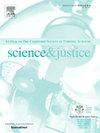A fast, low-cost, and nondestructive method using digital images to detect crossing pen ink lines in documents with old and recent writing
IF 1.9
4区 医学
Q2 MEDICINE, LEGAL
引用次数: 0
Abstract
In forensic document examination, the analysis of pen ink is crucial for detecting fraud, particularly by evaluating crossing ink lines. In this study, a fast, simple, non-destructive method was developed for detecting crossing lines of blue pen inks in documents with old and recent writing, using smartphone-based digital images. Digital images of three different regions of interest (ROI) in the areas with pen writing were acquired for twenty-six real documents containing blue pen inks, dated between the years 1994 and 2023. The ROIs were defined as follows: I – Document Pen Ink (DPI), II – Intersection Pen Ink (IPI), and III – Overlay Pen Ink (OPI), representing different areas of the original and crossed pen ink lines. ColorGrab® free smartphone software was used to capture and process the values of the Red (R), Green (G), Blue (B), Hue (H), Saturation (S), and Value (V) channels for the digital images of the pen inks for each ROI. The R, G, B, and V channels provided the best analytical responses for identifying crossing lines in the OPI regions of the documents, enabling distinction of the regions after data normalization and principal component analysis (PCA). Application of k-means cluster analysis showed that the method was able to effectively distinguish between older and more recent writing at the crossing pen ink lines. The development of this nondestructive method offers a promising way to identify pen ink line crossing in old documents that may have been tampered with by the introduction of more recent writing.
一种快速、低成本、无损的方法,使用数字图像检测文件中新旧文字的笔墨线
在法医文书检验中,笔墨分析是检测欺诈的关键,特别是通过笔墨交叉线的评估。在这项研究中,开发了一种快速、简单、无损的方法,用于使用基于智能手机的数字图像检测新旧书写文档中蓝色钢笔墨水的交叉线。研究人员从1994年至2023年间的26份包含蓝色钢笔墨水的真实文件中获得了钢笔书写区域中三个不同感兴趣区域(ROI)的数字图像。roi的定义如下:I - Document Pen Ink (DPI), II - Intersection Pen Ink (IPI), III - Overlay Pen Ink (OPI),代表原始和交叉笔墨线的不同区域。ColorGrab®免费智能手机软件用于捕获和处理红色(R),绿色(G),蓝色(B),色相(H),饱和度(S)和价值(V)通道的值,用于每个ROI的笔墨水的数字图像。R、G、B和V通道为识别文件OPI区域的交叉线提供了最佳的分析响应,使数据归一化和主成分分析(PCA)后的区域区分成为可能。k-means聚类分析的应用表明,该方法能够有效地区分笔墨线交叉处的旧字和新字。这种非破坏性方法的发展提供了一种很有前途的方法来识别旧文件中可能被引入的新文字篡改过的笔墨线。
本文章由计算机程序翻译,如有差异,请以英文原文为准。
求助全文
约1分钟内获得全文
求助全文
来源期刊

Science & Justice
医学-病理学
CiteScore
4.20
自引率
15.80%
发文量
98
审稿时长
81 days
期刊介绍:
Science & Justice provides a forum to promote communication and publication of original articles, reviews and correspondence on subjects that spark debates within the Forensic Science Community and the criminal justice sector. The journal provides a medium whereby all aspects of applying science to legal proceedings can be debated and progressed. Science & Justice is published six times a year, and will be of interest primarily to practising forensic scientists and their colleagues in related fields. It is chiefly concerned with the publication of formal scientific papers, in keeping with its international learned status, but will not accept any article describing experimentation on animals which does not meet strict ethical standards.
Promote communication and informed debate within the Forensic Science Community and the criminal justice sector.
To promote the publication of learned and original research findings from all areas of the forensic sciences and by so doing to advance the profession.
To promote the publication of case based material by way of case reviews.
To promote the publication of conference proceedings which are of interest to the forensic science community.
To provide a medium whereby all aspects of applying science to legal proceedings can be debated and progressed.
To appeal to all those with an interest in the forensic sciences.
 求助内容:
求助内容: 应助结果提醒方式:
应助结果提醒方式:


